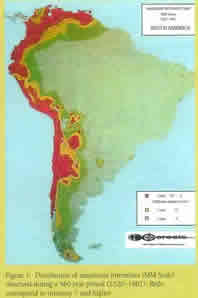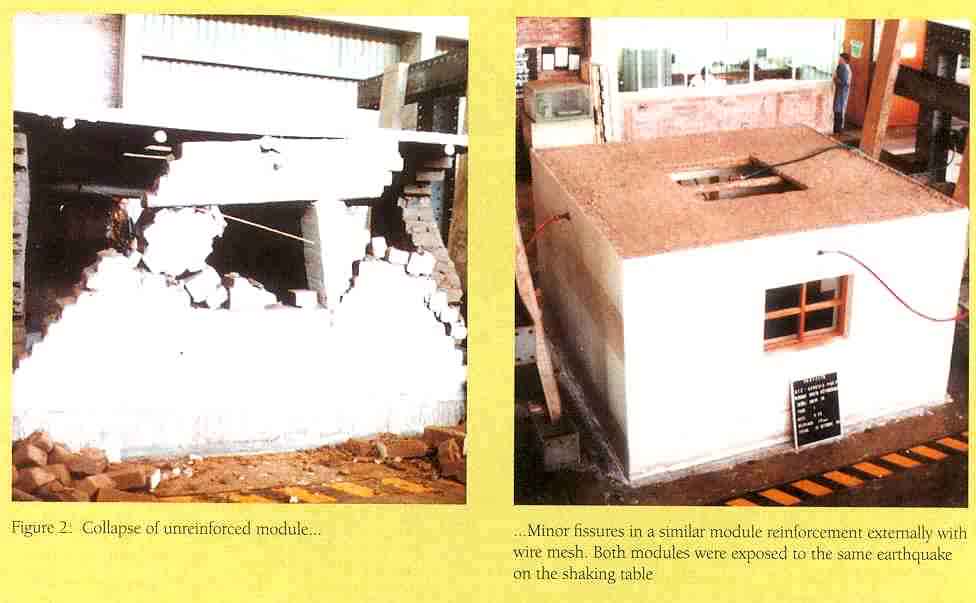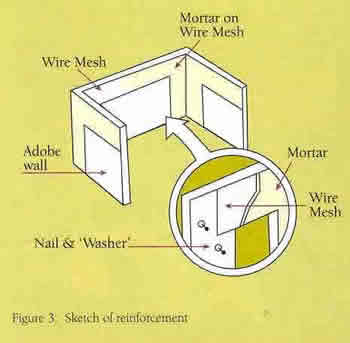Seismic Reinforcement of Existing Adobe Housing in the Andean Countries
THE ANDEAN countries of South America-Argentina, Bolivia, Chile, Colombia, Ecuador, Peru and Venezuela-have a combined population of about 140 million. Approximately 25% (35 million people) live in 'adobe' housing which is structurally vulnerable to earthquakes. Many millions of people throughout the developing world are in the same condition.
The Andean region is one of the most active seismic regions of the world; ¡t accounts for about 15% of the total seismic energy generated worldwide. In this century at least 450 earthquakes of magnitude 6.5 or greater have occurred in this region. The distribution of Maximum Intensities on the Mercalli Modified (MM) scale, as observed during this period, is shown in Figure 1. Note that strong earthquake induced ground shaking with Intensities varying from VII MM to X MM, shown by different shades of red, has been experienced throughout the entire Andean area. Damage to adobe construction ranges from serious -Intensity VII MM, to total destruction - Intensity X MM. A significant portion of the low income sector of the population live in vulnerable adobe housing in earthquake prone regions of the world; they, in particular, are in a high seismic risk situation. This is the kind of situation that the International Decade for the Reduction of Natural Disasters could not ignore.
The earthquake, if sufficiently close and strong enough,will not only destroy an adobe house in a few seconds but it is also likely to kill or bury the people inside the house when it collapses. We often learn, of hundreds or even thousands of people killed by an earthquake, in the Middle East, North Africa, China or Latin America, when a severe earthquake hits an adobe community-for example, 1944- San Juan, Argentina, 10,000 victims; 1976 Guatemala, 22,545 victims; 1970 -Ancash, Peru, 67,000 Victims; 1997-Iran, 1,567 victims.
BACKGROUND
Ceresis: The Regional Center for Seismology for South America-is an international organization created and supported by the governments of the South American countries, under a Multinational Agreement, ratified by law in each country. The purpose of Ceresis is to further the knowledge of seismology and related disciplines and to apply such knowledge to build up the region's capacity to cope with earthquake and volcanic hazards.
The critical shortage of housing throughout South America is a priority problem en the agenda of the governments in the region. On-going programmes, with varying degrees of success, provide better homes to a relatively small number of families that can afford to pay the respective lean. There are no programmes designed to solve the urgent dilemma of the millions threatened by an earthquake that can occur at any time, any day, whose adobe homes are particularly vulnerable to seismic excitation and whose income is at the poverty level.
The very important problem of reducing the seismic risk faced by 35,000,000 million people living in vulnerable adobe houses in earthquake-prone regions of South America is a challenge that Ceresis has to address.
The international IDNDR Scientific and Technical Committee (STC), appointed by the UN Secretary-General, held its First Session in Bonn, Germany, in March 1991. The Committee decided at that time that a certain number of projects should be executed as international demonstration projects for the IDNDR.
The STC Second Session was held in Guatemala City, Guatemala, in September 1991. Proposals for IDNDR demonstration projects having high potential for disaster mitigation were duly examined. In the area of Earthquake Hazards - Risk Assessment and Preventive Actions - a proposal presented by Ceresis to carry out such a project in the Andean region was approved. The project, designed to reduce earthquake effects, specifically to reduce the number of victims, proposed the reinforcement of adobe houses throughout the earthquake-prone areas.
Reinforcement of an adobe house so that it will react to seismic excitation as well as a well-built brick and concrete house and not collapse, is complicated and very expensive. The cost would exceed the funding capacity of housing programmes and of individual owners, and probably even the cost of building a new house. With this in mind, Ceresis proposed developing a simple technology designed to retard the collapse of the house and not necessarily to save the house. Adobe houses, unless exceptionally well built, are apt to collapse in a very few seconds when severely shaken.
If the earthquake occurs when people are indoors, a situation that is worsened if they are sleeping, they simply do not have enough time to escape outdoors to safety. Even though most adobe houses are rather small, offer escape routes to the front and to the rear of the house and are usually one story high, there can still be insufficient time for their occupants to get out. When the house collapses, quite often those inside are badly injured or crushed to death by the crumbling walls, heavy beams and clay tile roofs. Additional time, even a few seconds more with the house still standing, enables the dweller to escape alive and watch the house from the outdoors as it collapses, rather than being trapped inside, bad1y injured or dead.
The Ceresis proposal was brought to the attention of funding agencies by the IDNDR Secretariat as an IDNDR demonstration project. A few weeks after Guatemala, the German IDNDR National Committee informed Ceresis that the German Government was interested in the project. This was followed by prolonged negotiations leading to a formal Agreement signed by Ceresis and the German Co-operation for Development programme, duly represented by GTZ, for the transfer of DM 590,000,-the amount required by Ceresis to execute the proposed demonstration project during a four-year period.
THE DEMONSTRATION PROJECT
The objective of the project was to produce a well tested solution based on simple reinforcement technology which makes use of low cost readily available materials. For many, many years, empirical techniques to reinforce adobe housing have been applied by people for various reasons and with varying degrees of success. Some houses and schools have been reinforced to correct specific problems due to ground subsidence, uplift, wind erosion, rain or defective construction. The idea of reinforcing well preserved adobe houses as a preventive measure against eventual earthquakes has never been formally adopted, as far as we know, or incorporated in national, regional or local civil defence plans.
The Ceresis project included laboratory tests of known techniques, and of new ideas that would meet the requirements - low-cost, simple do-it-yourself technology, making use of available materials. Also considerable field work was undertaken to document potential difficulties arising from the broad spectrum of the quality of existing adobe houses. The final phases addressed the difficulty of 'marketing' the product, ie. spreading the message, gaming the confidence of the people and also having in place mechanisms to evaluate the behaviour of reinforced houses whenever a strong earthquake should occur.
A three-year laboratory research and testing programme was carried out with the large shaking table, 20 square meters, and other equipment installed and available at the Structures Laboratory of the Catholic University of Peru. The Laboratory is able to test fairly large scale models. Faculty members of the University's Department of Civil Engineering, with many years of experience with adobe construction, under a formal agreement with Ceresis, accepted the responsibility of executing the laboratory programme and selecting the technology that best met all of the requirements for a good solution to the problem. it might not be the very best technical solution, the cheapest, or the easiest to apply, but as a whole it had to be a viable and attractive option.
The movements of the shaking table simulate ground shaking under seismic excitation; the table is controlled by a computer that reproduces seismic waves as recorded by strong motion instruments. The acceleration can be regulated to produce moderate to severe shaking. On this table, successive modules were built and shaken with varying degrees of acceleration, both unreinforced modules and modules reinforced with rope, wooden planks, corner braces, ordinary chicken-wire, electro-welded wire mesh or a combination of these. Knowing the behaviour of unreinforced adobe modules is of the utmost importance to identify critical zones that need to be reinforced. Past earth- quakes in Peru, even some of moderate size, have confirmed the poor behaviour of adobe; some houses have collapsed very quickly with fatal consequences (Figure 2).
The fragile behaviour of adobe is due to the lack of a structural element that controls the size of the cracks, The cracks, in turn, cause sudden loss of lateral rigidity and convert the construction to a very flexible system with a large mass. This then generates the collapse as the seismic forces are greatly enhanced.
Basically, the reinforcement technique consists of nailing electrowelded wire mesh along the insides and outsides of adobe walls, connecting the two sheets of mesh using wire and then spreading cement mortar over them.
The mesh is placed in horizontal and vertical strips (simulating beams and columns, respectively) in the critical parts of the building. Their purpose is, together with the applied mortar, to prevent the abrupt loss of lateral rigidity that occurs when cracks form in non-reinforced buildings (Figure 3).
Pilot projects have been executed in six localities through- out Peru@, similar pilot projects are being carried out in Bolivia, Colombia, Chile, Ecuador and Venezuela, Strong motion seismic equipment is being installed in the localities where the projects have been carried out in Peru. The demonstration consists of reinforcing three or more buildings in each locality with materials provided by Ceresis. At the same time, local masons and the population in general are trained, Experience has shown that they quickly and correctly learn the technique; one has to remember that in general adobe houses are non-engineered and people build their own homes. So they themselves have the basic ability to apply the reinforcement, when properly instructed.
The technology has been adopted by the National Civil Defence Authority in Peru. Their local representatives will be asked to distribute flyers and manuals urging the people to make 'use of the available technology to 'vaccinate you home and save you and your family's lives'.
Although the cost of the materials is quite modest, the lack of financial resources is in many cases a major obstacle to die application of the reinforcement. At this stage, consideration is being given to government support possibly through a Materials Bank that will supply the two most expensive items -cement and wire mesh, at a low price and on a long-term credit basis. The loan required is estimated to be less than US$ 400 per house.
To conclude, the simple method of reinforcement Ceresis offers is suited for delaying the collapse of adobe dwellings in the Andean region when earthquakes occur. This gives the occupants enough time to get to a safer place, thus contributing to one of the ma or goals of IDNDR to reduce the number of victims of natural disasters.



